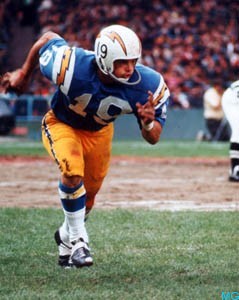While I presented the career list yesterday, I thought it would make sense to plot the career yards after removing junk yards (using 2.5x as the baseline) against each receiver’s plain career receiving yards (in both cases, since 1960). That’s what I’ve done in the graph below, with actual career receiving yards on the X-Axis and career yards after removing junk yards on the Y-Axis. Jerry Rice is literally off the chart (22,895; 13,786) because including him would require using a much broader (and less helpful) chart. Let’s just ignore Rice and focus on the other 99 receivers:

Players who are up high and to the left are the ones that benefit from this methodology. Two names that quickly stand out are Lance Alworth and Don Maynard. With Alworth, it’s because he did little in his first or last season, and was only serviceable in his second- and third-to last final seasons. In other words, it was the middle 7 seasons that turned him into an inner circle HOF wide receiver. Like Maynard, he benefits from the era adjustment, too; both were dominant receivers even though their numbers simply don’t quite hold up to today’s standards.
Consider:
- Among all receivers from 1960 to 2015, Maynard ranks 26th in receiving yards and Alworth ranks 42nd.
- Among that same set, Maynard ranks just 41st in games with at least 40+ yards, and Alworth ranks 69th. In other words, lots of receivers have had 40+ yards in a game very frequently, pushing those two down the career lists.
- Bump the number to 60+ yards, and they still struggle: Maynard is 37th, and Alworth is 60th.
- At 80+ yards, tho, things change: Maynard is now 17th, Alworth 30th; that’s higher than both fared in raw receiving yards.
- How about at 100+ yards? Maynard is 6th, and Alworth is 18th.
- And at 120+ yards? Alworth is tied for 3rd, Maynard is tied for 10th.
Some other AFL receivers, particularly guys who dominated in the early years like Art Powell and Charley Hennigan, fare much better once we remove junk yards and make era adjustments, too. But to look at some NFL players, I’ll note that Bob Hayes and Harold Jackson also stand out by this methodology.
Hayes ranks 48th in yards after removing junk seasons (using a 2.5X baseline); meanwhile, he ranks 101st in receiving yards from 1960 to 2015. Hayes, like Alworth, had a somewhat short peak: he was excellent from ’65 to ’71, but did almost nothing after that. From ’65 to ’71, Alworth had 7,405 yards, Maynard had 6,660 yards, Hayes had 6,617 yards… and no other player was within 1,000 yards of Hayes. He was a dominant player during that stretch and arguably the premier NFL wide receiver of the late ’60s.
Jackson also benefits from the era adjustments; in particular, he played during the truly dead ball era of the early ’70s. He ranks 40th in career receiving yards, but 25th by these metrics. Unlike Alworth and Hayes, Jackson had a very long career: he just benefits from putting up very solid games that don’t look quite as impressive now. For example, his 1972 season ranked 193rd among all seasons since 1960, using a 2.5X baseline even though he gained “only” 1048 yards. Conversely, Allen Robinson and his 1400-yard season last year ranked 203rd. A 1,048-yard season may not strike you as incredible, but Jackson led the league in receiving yards that year.
The table below shows the information on the graph above, but in table form:
While some players are helped out, obviously other players fare worse here. The most obvious examples are modern tight ends, like Tony Gonzalez, Antonio Gates, and Jason Witten. That’s not too surprising. Perhaps less-expected, tho, is Irving Fryar. From ’60 to ’15, he ranks 19th overall; meanwhile, he ranks only 31st once you remove junk seasons. One reason: he has the 3rd most games (85) of between 30 and 60 yards. Fryar was a great player, but he also hung around for a long time and had a lot of non-memorable games that added to his career numbers. He had about 2500 more career receiving yards than Alworth, but Alworth ranks 235th with just 36 games of between 30 and 60 yards.
What stands out to you?

